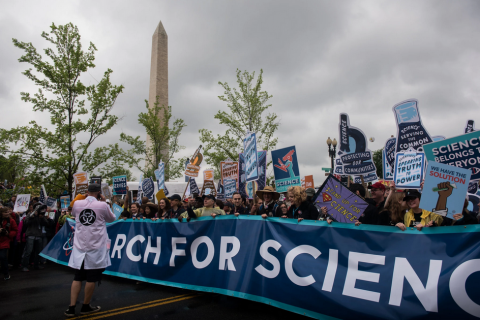The abundance and pace of knowledge creation today is unprecedented in human history. To activate this knowledge for transformational change requires the gamut of actors and actions, working together to accelerate sustained work to keep the planet from exceeding 1.5 degrees in warming. While the Global Council for Science and the Environment (GCSE) is a non-partisan nongovernmental organization, we value deeply our sister organizations and colleagues who demand decisive, swift action and leadership through activism. As an inclusive organization, GCSE is committed to the imperative of standing shoulder to shoulder with leaders, activists, innovators, and decision makers in all capacities to move forward the sum of all actions and approaches. Working in concert with all sectors and stakeholders will achieve the changes needed to effectively avert catastrophic impacts from climate change.
On this 51st Earth Day, GCSE extends its humble gratitude, as leaders around the world announce a groundswell of commitments to work together to meet the crisis of climate change facing humanity. Deepest thanks also to Earth Day Network President Kathleen Rogers for the rallying cry in her essay this month. GCSE extends its gratitude to all who have, and continue to, work with an unwavering commitment to realize an equitable, thriving planet made possible through science, leadership, and action.
–Michelle Wyman
Scientists have always played a key role in protecting the planet and the link between science and environmental action has been around at least 3000 years or longer. Many ancient cultures, relying on the earliest scientific observations, recognized the health consequences of air pollution, mining, soil erosion, biodiversity loss, and other human activities and made efforts to stem their consequences. Yet over the centuries, the groundbreaking work of scientists has often been ignored, even derided, the consequences of which have played out in history over and over. The tragedy of the current human condition is largely the result of the failure of governments and corporations to heed the warnings of environmental scientists, increasing the risks to human health and stymieing discoveries and inventions that might solve those problems. Climate change presents a perfect example. While most people consider global warming a recent scientific observation, it was first recognized in the 1820s, when French mathematician Jean Baptiste Fourier demonstrated that thermal energy emissions were being trapped inside the earth’s atmosphere, effectively wrapping a blanket around the planet. By the 1950s, oil companies knew for sure that burning fossil fuels was overheating the planet but kept the information hidden. It wasn’t until scientists brought the issue to the world’s attention that governments took action.
Activist scientists are not a new phenomenon. From scientist Alice Hamilton who campaigned in the 1900s against leaded gas, mercury poisoning, and other toxins to George Washington Carver who changed agriculture with his studies and activism on soil depletion to Rachel Carson who warned about the impacts of DDT, scientists have led the way on environmental progress, particularly those to have combined their research with a willingness to speak up. Environmentalism would not exist without activist scientists.

The first Earth Day was a watershed moment for environmental protection, and scientists led the way here too. For more than a century leading up to the first Earth Day, Americans were consuming vast amounts of leaded gas through massive and inefficient automobiles. Industry belched out smoke with little fear of the consequences from either the law or bad press. Air pollution was commonly accepted as the smell of prosperity. All the while, scientists were producing papers and communications about the impacts of 150 years of industrial development. Scientists were also forming environmental groups, mostly focused on wildlife and land conservation. Yet mainstream America and much of the world remained largely oblivious to environmental concerns and how a polluted toxic environment threatens human health. By the late 1960s, environmental scientists, who had painstakingly proved the connections between environmental pollutants and disastrous outcomes for human beings, slowly found a broader audience and national consciousness grew.
The first Earth Day on April 22, 1970, which brought out 20 million people to the streets in what remains the largest civic event in human history, would not have happened without scientists. Organizations, many founded by scientists, which had been fighting individually against oil spills, polluting factories and power plants, raw sewage, toxic dumps, pesticides, freeways, the loss of wilderness, and the extinction of wildlife united on Earth Day. It was scientists who created the pathway to that massive public outcry. By the end of 1970, the first Earth Day and the science that supported the movement led to the creation of the United States Environmental Protection Agency (EPA) and the passage of other first of their kind environmental laws, including the National Environmental Education Act, the Occupational Safety and Health Act, and the Clean Air Act. Two years later Congress passed the Clean Water Act. A year after that, Congress passed the Endangered Species Act and soon after the Federal Insecticide, Fungicide, and Rodenticide Act. These laws have protected millions of men, women, and children from disease and death and have protected hundreds of species from extinction.
Fast forward half a century, and America is divided about their trust in science, particularly on the environment. This can be attributed to several key factors: messages from political leaders, peak levels of division between political ideologies, and a slew of misinformation. In 2016, the Trump Administration significantly downsized the role of science in federal policymaking and regulatory decisions, especially when it came to public health, energy, and the environment. The White House publicly stated that “businesses are finally being freed of Washington’s overreach, and the American economy is flourishing as a result,” and taxpayers should not be the ones to fund these projects. By cutting staff departments like the EPA and eliminating federally funded research projects in the name of progress, the Trump Administration continued to chip away at public trust in science. Throughout the Trump presidency, misinformation ran wild, with the Administration calling climate change a “hoax” and officially pulling out the Paris Agreement.

Given the diminishing role of science in American public policy amid the Trump Administration and in other countries around the world, many felt the need to stand up for this important cause, leading to the 2017 March for Science. Co-organized in Washington, D.C. by EarthDay.org, this rally brought together scientists and supporters to demand that our leaders recognize the scientific truths across all disciplines, including climate change and other environmental issues. Thousands of people marched in cities around the U.S. including Washington, D.C., Boston, New York, Chicago, Los Angeles, San Francisco, and in countries around the globe such as Germany, New Zealand, Australia, France, Ireland, Finland, Portugal, and the Netherlands. Individuals took a public stand to support scientific research and evidence-based policies at a time where the politicization of science had given policymakers permission to reject overwhelming evidence.
Trust in science has still been largely polarized over the last several years, undermining public trust and the consensus building needed to solve the climate crises. According to a Pew Research Center study from 2019-2020, 62% of Americans on the left have a lot of trust in scientists, compared with 20% of individuals on the right. The difference is similar among party identification, 67% of liberal Democrats say they have a lot of trust in scientists, compared to 17% of conservative Republicans. The trend remains consistent regarding the public’s view on climate change. 86% of Americans on the left say, “climate change is a very serious problem,” compared to 22% on the right. This divide can be attributed to individuals seeking out information based on their beliefs which influences their actions.
However, there are indications that shifts are beginning to happen in the public’s belief in science. According to the 3M State of Science Index Survey, science skepticism around the world has declined for the first time in three years. In 2018, 28% of respondents noted they are “skeptical of science” compared to 32% in 2019, 35% in pre-pandemic 2020, and 28% in 2020 after the pandemic hit. Additionally, the coronavirus pandemic has increased the importance of science in society around the world. 69% of respondents indicated “science is very important to society in general,” up 11 points from the pre-pandemic study.
Scientists themselves have often cautioned against scientists becoming activists. According to Editor-in-Chief of Environmental Science & Technology, David Sedlak, activism can undermine the “standing of academics as objective seekers of truth.” While many risks could potentially come from scientists “crossing the imaginary line,” scientists are able to provide critical expertise and point to the areas that need further examination and action. Activist scientists create a powerful force to ultimately inspire change through facts and evidence. They play a critical role in disseminating scientific facts on numerous issues, including climate change.
Activist scientists have always been and continue to be a critical part of the environmental movement and Earth Day worldwide. With less than a decade left to save humanity from the climate crisis, there is a dire need for activist scientists to raise the alarm to the general public, advocate for climate science, and provide evidence-based solutions to restore our planet. It’s vital that their voices are heard.
The opinions expressed in this essay are those of the author. They do not purport to reflect the opinions or views of the GCSE or its members.